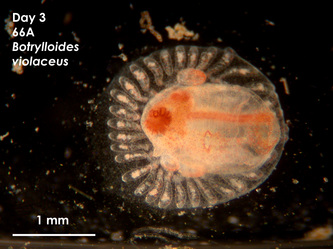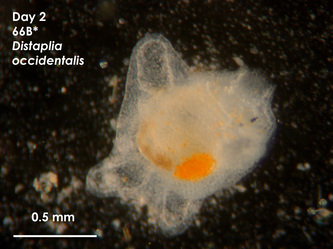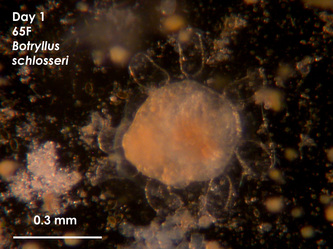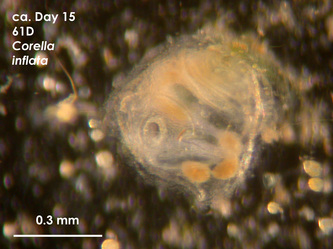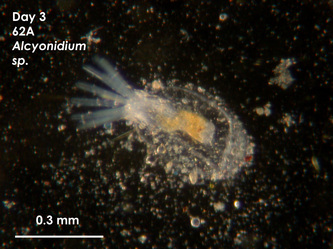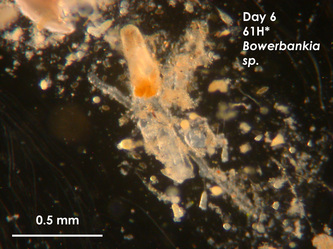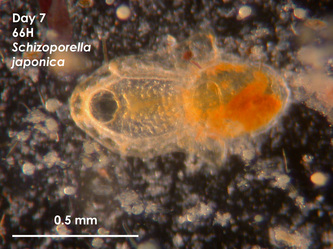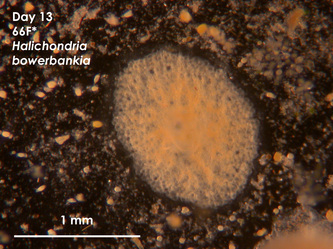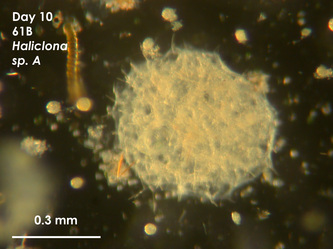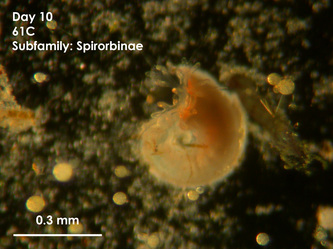Identification Key
This website is designed to help identify some common settling organisms during their juvenile stage.
Guide to photographs:
Each photograph is labeled with
- Day- The day on which the individual was first observed is Day 1, the second day is Day 2, etc.
- Specimen name- Each individual was given a name. The name includes the number assigned to the petri dish upon which the individual settled, and a letter corresponding to how many individuals had already been observed on that dish.
- Scientific name- Each individual was taxonomically identified to genus and species when possible.
- Scale bar- The length of the bar represents the printed numeric value in millimeters.
Guide to photographs:
Each photograph is labeled with
- Day- The day on which the individual was first observed is Day 1, the second day is Day 2, etc.
- Specimen name- Each individual was given a name. The name includes the number assigned to the petri dish upon which the individual settled, and a letter corresponding to how many individuals had already been observed on that dish.
- Scientific name- Each individual was taxonomically identified to genus and species when possible.
- Scale bar- The length of the bar represents the printed numeric value in millimeters.
Ascidians
Characteristics:
Transparent body parts that look and feel gelatinous
Two or more nozzle-shaped siphons, sucking in or expelling water
(Older juveniles) Movement of internal cilia
Transparent body parts that look and feel gelatinous
Two or more nozzle-shaped siphons, sucking in or expelling water
(Older juveniles) Movement of internal cilia
Bryozoans
Characteristics:
A lophophore (feeding organ):
compressed, comb-like striations inside of the body when retracted
thin, fibrous, and flower-like tendrils extruded from a hole in the body when extended
A lophophore (feeding organ):
compressed, comb-like striations inside of the body when retracted
thin, fibrous, and flower-like tendrils extruded from a hole in the body when extended
Sponges
Characteristics:
Textured, gritty appearance
May have visible oscula- circular pores
May have spicules- transparent, needle-like spines that look like thin shards of broken glass
Textured, gritty appearance
May have visible oscula- circular pores
May have spicules- transparent, needle-like spines that look like thin shards of broken glass
Polychaete Worms
Characteristics of spirorbin worms:
Spiral, calcareous shell
Eyes and modified setae (appendages) that extend from the mouth of the shell
Spiral, calcareous shell
Eyes and modified setae (appendages) that extend from the mouth of the shell
Barnacles
Characteristics:
Oval, dome-shaped shell
Distinct, back and forth movement of the organism inside
Slit-like opening (aperture) running down the middle of the shell
Balanus crenatus
Oval, dome-shaped shell
Distinct, back and forth movement of the organism inside
Slit-like opening (aperture) running down the middle of the shell
Balanus crenatus
Hydroids
Characteristics:
Long branches with tentacled polyps (hydranths) at the ends
Polyps may be enclosed in a clear, glassy encasing (hydrotheca)
May grow stolons (hydrorhiza) that attach the polyps to the substrate
A clear, gelatinous covering (perisarc) over the polyps and the stolons
Mitrocoma cellularia Obelia sp.
Long branches with tentacled polyps (hydranths) at the ends
Polyps may be enclosed in a clear, glassy encasing (hydrotheca)
May grow stolons (hydrorhiza) that attach the polyps to the substrate
A clear, gelatinous covering (perisarc) over the polyps and the stolons
Mitrocoma cellularia Obelia sp.
